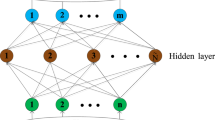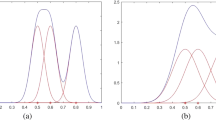Abstract
Time series prediction (TSP) is a process of using data collected at different times in the past for statistical analysis, so as to speculate on the trend of things, where the non-stationary and non-linear characteristics of data portray a hard setting for predictive tasks. Obviously, there will be no single model that could perform the best for all TSP issues. Dynamic Ensemble Selection (DES) technique achieves more accurate and robust performance than a single model, due to that it aims to select an ensemble of the most competent models in a dynamic fashion according to each test sample. A variety of DES approaches have been proposed to address pattern classification problems, but little work has been conducted on the research of TSP adopting the DES paradigm. Commonly, the DES approaches work by the definition of a single criterion to evaluate the capability of base classifiers. However, only one criterion is often inadequate for the comprehensive evaluation of classifier power. Thus, in this paper, a multiple criteria Dynamic Ensemble Pruning (DEP) technique exploiting meta-learning ad-hoc for TSP, termed DEP-TSPmeta, based on the inspiration from a state-of-the-art META-DES framework specifically presented for classification tasks, is developed. Within DEP-TSPmeta, Extreme Learning Machines (ELMs) and Hierarchical Extreme Learning Machines (H-ELMs) are integrated as the base models, and four distinct meta-attributes collections, i.e., hard prediction, local accuracy, global accuracy, and prediction confidence, are presented. Each set of meta-attributes corresponds to a specific assessment criterion, i.e., the prediction accuracy in local area of the eigenspace, the overall local accuracy, the prediction accuracy in global area of the decision space, and the confidence level of predictor. A desirable meta-predictor, obtained by training on the strength of these meta-attributes, is the key to deciding whether a base predictor is capable of predicting the unseen instance well or not. Those incapable base predictors determined by the meta-predictor will be pruned and the capable predictors will be expanded into the final dynamic ensemble system. The size of the sets of meta-attributes is specified dynamically by genetic algorithm for different time series benchmark datasets. Empirical results on eight benchmark datasets with different time granularities have verified that, the proposed DEP-TSPmeta algorithm possesses dramatically improved prediction performance at different granularities, when compared against three other DES approaches and four static selective ensemble learning methods.












Similar content being viewed by others
References
Kayacan E, Ulutas B, Kaynak O (2010) Grey system theory-based models in time series prediction. Expert Syst Appl 37:1784–1789
Chen CF, Lai MC, Yeh CC (2012) Forecasting tourism demand based on empirical mode decomposition and neural network. Knowl-Based Syst 26:281–287
Xia M, Wong WK (2014) A seasonal discrete grey forecasting model for fashion retailing. Knowl-Based Syst 57:119–126
Langella G, Basile A, Bonfante A, Terribile F (2010) High-resolution space-time rainfall analysis using integrated ANN inference systems. J Hydrol 387:328–342
Ailliot P, Monbet V (2012) Markov-switching autoregressive models for wind time series. Environ Model Softw 30:92–101
Moura MD, Zio E, Lins ID, Droguett E (2011) Failure and reliability prediction by support vector machines regression of time series data. Reliab Eng Syst Saf 96:1527–1534
Yu L, Dai W, Tang L (2015) A novel decomposition ensemble model with extended extreme learning machine for crude oil price forecasting. Eng Appl Artif Intell 47:110–121
Huang G-B, Zhu Q-Y, Siew C-K (2006) Extreme learning machine: theory and applications. Neurocomputing 70:489–501
Wong WK, Guo ZX (2010) A hybrid intelligent model for medium-term sales forecasting in fashion retail supply chains using extreme learning machine and harmony search algorithm. Int J Prod Econ 128:614–624
Shrivastava NA, Panigrahi BK (2014) A hybrid wavelet-ELM based short term price forecasting for electricity markets. Int J Electr Power Energy Syst 55:41–50
Huixin T, Bo M A new modeling method based on bagging ELM for day-ahead electricity price prediction, In: 2010 IEEE 5th International Conference on Bio-Inspired Computing: Theories and Applications, Changsha, 2010, pp 1076–1079
Tang JX, Deng CW, Huang GB (2016) Extreme Learning Machine for Multilayer Perceptron. IEEE Transactions on Neural Networks and Learning Systems 27:809–821
Baxt WG (1992) Improving the accuracy of an artificial neural network using multiple differently trained networks. Neural Comput 4:772–780
Wedding DK II, Cios KJ (1996) Time series forecasting by combining RBF networks, certainty factors, and the Box-Jenkins model. Neurocomputing 10:149–168
Krogh A, Vedelsby J (1995) Neural network ensembles, cross validation, and active learning. In Advances in Neural Information Processing Systems, Denver, pp 231–238
dos Santos EM, Sabourin R, Maupin P (2007) Single and multi-objective genetic algorithms for the selection of ensemble of classifiers, In 2006 International Joint Conference on Neural Networks, Vancouver, pp 3070–3077
Brown G, Wyatt J, Harris R, Yao X (2005) Diversity creation methods: a survey and categorisation. InfFusion 6:5–20
Kraipeerapun P, Fung C, Nakkrasae S (2009) Porosity prediction using bagging of complementary neural networks. In 6th International Symposium on Neural Networks, Berlin, pp 175–184
Lysiak R, Kurzynski M, Woloszynski T (2014) Optimal selection of ensemble classifiers using measures of competence and diversity of base classifiers. Neurocomputing 126:29–35
Cavalin PR, Sabourin R, Suen CY (2013) Dynamic selection approaches for multiple classifier systems. Neural Comput Appl 22:673–688
Cruz RMO, Sabourin R, Cavalcanti GDC (2018) Prototype selection for dynamic classifier and ensemble selection. Neural Comput Appl 29:447–457
Yao CS, Dai Q, Song G (2019) Several novel dynamic ensemble selection algorithms for time series prediction. Neural Process Lett 50:1789–1829
Cruz RMO, Sabourin R, Cavalcanti GDC (2018) Dynamic classifier selection: recent advances and perspectives. Inf Fusion 41:195–216
Cruz RMO, Sabourin R, Cavalcanti GDC, Ren TI (2015) META-DES: a dynamic ensemble selection framework using meta-learning. Pattern Recogn 48:1925–1935
Cruz RMO, Sabourin R, and Cavalcanti GDC, META-DES.H: a dynamic ensemble selection technique using meta-learning and a dynamic weighting approach, In 2015 International Joint Conference on Neural Networks, New York, 2015, pp 1–8
Cruz RMO, Sabourin R, Cavalcanti GDC (2017) META-DES. Oracle: meta-learning and feature selection for dynamic ensemble selection. Inf Fusion 38:84–103
Huang GB (2014) An insight into extreme learning machines: random neurons, random features and kernels. Cogn Comput 6:376–390
Huang GB, Zhou HM, Ding XJ, Zhang R (2012) Extreme learning machine for regression and multiclass classification. IEEE Trans Syst Man Cybern Part B 42:513–529
Bengio Y (2009) Learning deep architectures for Al. Found Trends Mach Learn 2:1–127
Vincent P, Larochelle H, Bengio Y, Manzagol PA (2008) Extracting and composing robust features with denoising autoencoders, In International Conference on Machine Learning, Helsinki, Finland, p. 1096–1103
Hinton GE, Salakhutdinov RR (2006) Reducing the dimensionality of data with neural networks. Science 313:504–507
Hinton GE, Osindero S, Teh YW (2006) A fast learning algorithm for deep belief nets. Neural Comput 18:1527–1554
Bengio Y, Courville A, Vincent P (2013) Representation Learning: a Review and New Perspectives. IEEE Trans Pattern Anal Mach Intell 35:1798–1828
Huang GB, Li MB, Chen L, Siew CK (2008) Incremental extreme learning machine with fully complex hidden nodes. Neurocomputing 71:576–583
Beck A, Teboulle M (2009) A Fast Iterative Shrinkage-Thresholding Algorithm for Linear Inverse Problems. Siam Journal on Imaging Sciences 2:183–202
Beck A, Teboulle M (2009) Fast gradient-based algorithms for constrained total variation image denoising and deblurring problems. IEEE Trans Image Process 18:2419–2434
Cruz RMO, Cavalcanti GDC, Ren TI, IEEE (2011) A method for dynamic ensemble selection based on a filter and an adaptive distance to improve the quality of the regions of competence, In 2011 International Joint Conference on Neural Networks, San Jose, CA, pp 1126–1133
Zhou ZH, Wu J, Jiang Y, Chen S (2001) Genetic algorithm based selective neural network ensemble, In International Joint Conference on Artificial Intelligence, Seattle, Washington, USA, pp 797–802
Whitley D (1994) A genetic algorithm tutorial. Stat Comput 4:65–85
Horn J, Nafpliotis N, Goldberg DE (1994) A niched Pareto genetic algorithm for multiobjective optimization. In Proceedings of 1th IEEE Conference on Evolutionary Computation, Orlando, FL, USA, pp 82–87
Deb K, Agrawal S, PratapA, Meyarivan T (2000) A fast elitist non-dominated sorting genetic algorithm for multi-objective optimization: NSGA-II. In Proceedings of 6th International Conference on Parallel Problem Solving from Nature, Paris, France, pp 849–858
Rudolph G (1994) Convergence analysis of canonical genetic algorithms. IEEE Trans Neural Networks 5:96–101
Corne DW, Knowles JD (2003) No free lunch and free leftovers theorems for multiobjective optimisation problems. In International Conference on Evolutionary Multi-Criterion Optimization, pp 327–341
Ho YC, Pepyne DL (2002) Simple explanation of the no-free-lunch theorem and its implications. J Optim Theory Appl 115:549–570
Hyndman R, Yang Y. tsdl: Time Series Data Library. v0.1.0. https://pkg.yangzhuoranyang.com/tsdl/
Yahoo Finance[EB/OL]. https://finance.yahoo.com/
Mean absolute .https://en.wikipedia.org/wiki/Mean_absolute_error
Root-mean-square deviation. https://en.wikipedia.org/wiki/Root-mean-square_deviation
Arlot S, Celisse A (2010) A survey of cross-validation procedures for model selection. Stat Surv 4:40–79
Rodriguez-Fdez I, Canosa A, Mucientes M, Bugarin A (2015) STAC: A web platform for the comparison of algorithms using statistical tests. In IEEE International Conference on Fuzzy Systems, Istanbul, Turkey, pp 1–8
Demiar J, Schuurmans D (2006) Statistical comparisons of classifiers over multiple data sets. J Mach Learn Res 7:1–30
Finner H (1993) On a monotonicity problem in step-down multiple test procedures. J Am Stat Assoc 88:920–923
Kuncheva LI (2002) A theoretical study on six classifier fusion strategies. IEEE Trans Pattern Anal Mach Intell 24:281–286
Acknowledgements
This work is supported by the National Key R&D Program of China (Grant Nos. 2018YFC2001600, 2018YFC2001602), and the National Natural Science Foundation of China under Grant No. 61473150.
Author information
Authors and Affiliations
Corresponding author
Additional information
Publisher's Note
Springer Nature remains neutral with regard to jurisdictional claims in published maps and institutional affiliations.
Rights and permissions
About this article
Cite this article
Zhang, J., Dai, Q. & Yao, C. DEP-TSPmeta: a multiple criteria Dynamic Ensemble Pruning technique ad-hoc for time series prediction. Int. J. Mach. Learn. & Cyber. 12, 2213–2236 (2021). https://doi.org/10.1007/s13042-021-01302-y
Received:
Accepted:
Published:
Issue Date:
DOI: https://doi.org/10.1007/s13042-021-01302-y




